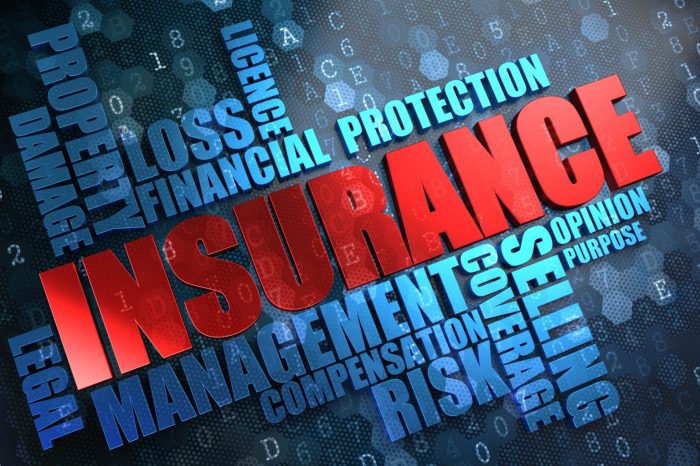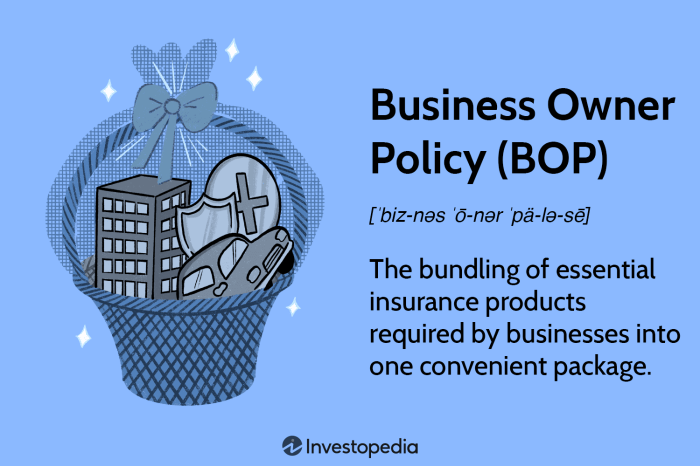Securing your business’s future requires a robust safety net, and that’s where a Business Owners Policy (BOP) insurance comes in. This comprehensive insurance package bundles multiple crucial coverages into one convenient policy, offering significant cost savings and streamlined risk management for small business owners. Understanding the intricacies of a BOP can be the difference between weathering unexpected storms and facing financial ruin. This guide provides a clear and concise overview, empowering you to make informed decisions about protecting your valuable assets and business operations.
From understanding the core components of a BOP to navigating the claims process, we’ll explore the key features and benefits, helping you determine if this type of insurance is the right fit for your specific business needs. We’ll also delve into customizing your policy to ensure optimal protection and discuss common misconceptions surrounding BOP coverage.
What is a Business Owners Policy (BOP)?
A Business Owners Policy (BOP) is a comprehensive insurance package designed specifically for small to medium-sized businesses. It bundles several essential coverages into a single, convenient policy, simplifying insurance management and often offering cost savings compared to purchasing each coverage individually. Think of it as an all-in-one solution for protecting your business’s assets and operations.
A BOP typically includes property insurance, liability insurance, and business interruption insurance. Property insurance covers physical damage to your business property, such as buildings and equipment, from events like fire, theft, or vandalism. Liability insurance protects your business from financial losses resulting from lawsuits due to bodily injury or property damage caused by your business operations. Business interruption insurance covers lost income and expenses if your business is forced to temporarily close due to a covered event. The specific components and coverage limits are customizable to meet the individual needs of each business.
Core Components of a BOP
A standard BOP policy usually comprises several key components. These components work together to provide comprehensive protection against a wide range of risks. Understanding these components is crucial for selecting the appropriate level of coverage.
Property coverage protects your business’s physical assets, including the building, its contents, and any other business personal property. This often includes coverage for damage from fire, windstorms, vandalism, and other specified perils. Liability coverage protects your business from financial losses due to third-party claims of bodily injury or property damage caused by your business operations or employees. This also often includes coverage for advertising injury and personal injury. Business interruption insurance helps compensate for lost income and extra expenses incurred when a covered event forces your business to temporarily close. This could include costs associated with relocating temporarily or maintaining essential operations elsewhere.
Businesses That Benefit From a BOP
Many types of small and medium-sized businesses can significantly benefit from the comprehensive protection offered by a BOP. The simplicity and cost-effectiveness make it an attractive option for various business structures and industries.
Examples include retail stores, restaurants, offices, small manufacturing facilities, and professional service providers like consultants or designers. Essentially, any business that owns property, employs people, and interacts with the public could find a BOP beneficial. A small bakery, for instance, would be protected against fire damage to its building and equipment (property), a lawsuit from a customer who slips and falls (liability), and lost income if a fire forces a temporary closure (business interruption). Similarly, a consulting firm could be covered for liability claims related to professional negligence and business interruption if a cyberattack compromises their operations.
Comparison with Other Business Insurance
A BOP differs from other business insurance policies in its comprehensive nature and bundled approach. While other policies focus on specific risks, a BOP combines several key coverages into one policy.
For example, a general liability policy only covers liability claims, while a commercial property policy only covers damage to the business’s property. A BOP offers both, along with business interruption coverage, making it a more efficient and often more cost-effective solution for many small businesses. However, businesses with unique or high-risk needs may require additional, specialized insurance policies beyond a BOP to fully address their exposure. For instance, a construction company might need a separate workers’ compensation policy due to the inherent risks associated with that industry, even if they also hold a BOP.
The Process of Obtaining a BOP

Securing a Business Owners Policy (BOP) involves several key steps, from obtaining quotes to finalizing the purchase. Understanding this process ensures you get the right coverage at the best price. The entire process is designed to assess your business’s risk profile and match it with appropriate insurance protection.
Obtaining a BOP Quote
To receive a BOP quote, you’ll typically interact with an insurance agent or directly with an insurance company’s website. The initial phase focuses on gathering preliminary information about your business. Providing accurate and comprehensive details is crucial for receiving an accurate quote. An inaccurate assessment can lead to inadequate coverage or inflated premiums.
Information Required from a Business Owner
Insurance providers require detailed information to accurately assess your risk. This typically includes your business’s legal structure (sole proprietorship, LLC, corporation, etc.), physical address, type of business, annual revenue, number of employees, and a description of your operations. They’ll also want details about your property, including its value and any security measures in place. Further, information regarding past insurance claims and any incidents that might affect your risk profile is necessary. For example, a history of theft would necessitate a more in-depth risk assessment. Providing this information honestly and completely is paramount to obtaining the correct coverage.
Factors Considered When Assessing Risk
Insurance providers use a variety of factors to determine the level of risk associated with your business. These include the nature of your business (some businesses inherently carry more risk than others), your business location (high-crime areas might lead to higher premiums), your claims history (previous claims can signal higher risk), the value of your property and equipment, and the adequacy of your security measures. For example, a restaurant in a high-traffic area might face higher premiums than a similar restaurant in a quieter location due to the increased potential for accidents or liability claims. Similarly, a business with a history of property damage claims will likely face higher premiums than a business with a clean record.
A Step-by-Step Guide for Purchasing a BOP
- Gather Information: Compile all necessary information about your business, including legal structure, address, revenue, employees, and operational details.
- Contact Insurance Providers: Reach out to multiple insurance providers to obtain quotes. This allows for comparison shopping and finding the best policy for your needs.
- Review Quotes Carefully: Compare quotes based on coverage, premiums, and deductibles. Ensure you understand the terms and conditions of each policy.
- Complete the Application: Once you’ve chosen a provider, complete the application accurately and thoroughly. Any inaccuracies can delay the process or invalidate your coverage.
- Provide Necessary Documentation: Submit any required documentation, such as proof of ownership or financial statements.
- Review and Sign the Policy: Carefully review the final policy document before signing. Understand the coverage limits, exclusions, and any conditions.
- Make Payment: Make the necessary premium payment to activate your policy.
Illustrative Examples of BOP Coverage in Action

Understanding BOP coverage is best done through real-world examples. The following scenarios illustrate how different aspects of a Business Owners Policy can protect your business from various risks.
Property Damage Coverage
Imagine Sarah owns a small bakery. A sudden, unexpected thunderstorm causes a significant portion of her shop’s roof to collapse, damaging baking equipment and inventory. Sarah’s BOP, which includes property damage coverage, steps in to cover the costs of repairing the roof, replacing the damaged equipment (oven, mixers, etc.), and compensating for the spoiled inventory. The policy would likely have a deductible, which Sarah would pay first, before the insurance company covers the remaining costs up to her policy’s limit. This avoids a potentially devastating financial blow to her business. The specific amount covered would depend on the details of her policy and the extent of the damage.
Liability Coverage
John runs a landscaping business. While working at a client’s home, one of his employees accidentally damages a valuable antique statue. The client sues John’s business for the cost of repairing or replacing the statue. John’s BOP liability coverage protects him by covering the legal costs associated with defending the lawsuit and any financial settlements or judgments awarded to the client. This coverage extends to bodily injury as well; if someone were injured on John’s property or as a result of his business operations, the liability coverage would help to cover medical expenses and legal fees.
Business Interruption Coverage
A fire severely damages Maria’s bookstore, forcing her to close for several months while repairs are made. Her Business Interruption coverage, a component of her BOP, kicks in to compensate her for lost income during this period. This coverage helps cover Maria’s ongoing expenses like rent, utilities, and employee salaries, even though she isn’t generating revenue. The policy may also cover the cost of relocating temporarily to a new space, ensuring business continuity. The payout is usually based on Maria’s average income before the incident, calculated according to the terms of her specific policy.
Successful BOP Claim
A local coffee shop experienced a water pipe burst during a severe winter storm. The resulting water damage significantly impacted the shop’s interior, requiring extensive repairs and replacement of damaged equipment. The shop owner filed a claim under their BOP’s property damage coverage. After providing necessary documentation, including photos of the damage and repair invoices, the insurance company assessed the claim and approved coverage for the repairs, equipment replacement, and some business interruption expenses. The prompt and efficient claim process allowed the coffee shop to reopen relatively quickly, minimizing the impact of the incident on their business. This demonstrates the value of having adequate insurance and a well-defined claim process.
Closing Summary

A Business Owners Policy offers a powerful and cost-effective way for small business owners to protect their investments and mitigate potential risks. By understanding the key features, coverage limits, and the claims process, you can confidently navigate the world of business insurance and secure the financial stability of your enterprise. Remember to regularly review your policy and adjust coverage as your business grows and evolves. Proactive insurance planning is a cornerstone of long-term business success.
FAQ Insights
What types of businesses are ineligible for a BOP?
Businesses considered high-risk, such as those involved in hazardous materials handling or those with a history of significant claims, may find it difficult to secure a BOP or may face higher premiums.
Can I add coverage for professional liability (errors and omissions) to my BOP?
Yes, many insurers offer professional liability coverage as an endorsement or add-on to a standard BOP, especially beneficial for businesses offering professional services.
How often should I review my BOP policy?
It’s recommended to review your BOP annually, or whenever significant changes occur within your business, such as expansion, acquisition of new equipment, or changes in operations.
What happens if I file a fraudulent claim?
Filing a fraudulent claim can lead to policy cancellation, denial of future claims, and potential legal consequences.
What is the difference between a BOP and a Commercial Package Policy (CPP)?
While both offer bundled coverage, CPPs are more comprehensive and customizable, often better suited for larger or more complex businesses. BOPs are generally designed for smaller businesses with simpler insurance needs.